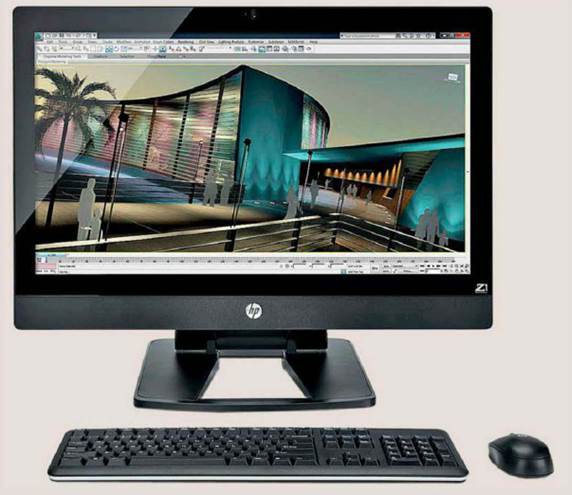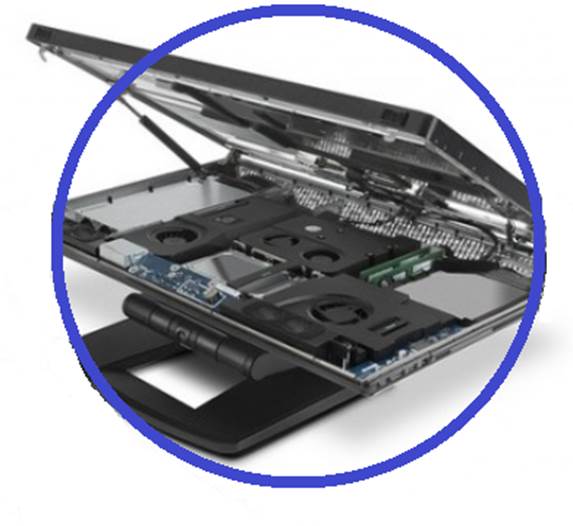A stylish and upgradeable all-in-one
workstation
The HP Z1 All-in-One (AIO workstation is
unique because it is targeted at prosumers and professional but more
importantly, is also upgradeable. In fact, HP touts the Z1 as the world’s first
upgradeable AIO workstation.
Aesthetically, the Z1 is stylish and would
easily up the hip-quotient of any work desk. It has a clean, minimalist look,
but it is also an imposing piece of kit thanks to its massive 27-inch, 2560 x
1440 pixel resolution IPS display. The unit weighs around 20kg, which is
actually decent, considering it houses not only the screen but also all the
components such as the processor, memory, heatsinks, graphics card, power
supply and blowers.

HP
Z1 All-In-One Workstation
The heft of the Z1 is supported by a
cleverly-engineered stand which tilts forwards and black, and can also be
adjusted for height. It also enables the Z1 to be folded horizontally flat,
whereby users can then access the components of the Z1 by undoing two latches
at the bottom of the screen. A damper helps lift the heavy screen up. Inside
the Z1, you’ll find that the components are neatly compartmentalized and there’s
a multitude of blowers to help keep things cool.
The Z1 is highly configurable and prices
start a reasonable US$1,800. However, once you start selecting higher-end
workstation-grade components, the price starts to increase dramatically. Our
test system which comes with a Xeon processor, 16GB of ECC memory and a
professional-grade Quadro 4000M graphics card came up to an eye-watering
US$5,000.
Since the Z1 is the first of its kind, we
decided to use a comparable desktop system that we assembled ourselves to serve
as a point of reference, rather than an outright apples-to=apples comparison.
Directly comparing the two would be missing the point, because the Z1 has an
entirely unique form factor and comes with a comprehensive warranty and
support. Our self-assembled system is instead here to provide a big-picture
perspective of what you can expect in terms of performance if you are buying a
workstation right off the shelf, as opposed to building one yourself.
In this case, we managed to almost match
the Z1 spec-for-spec, save for the slightly higher-clocked Core-i7 2600k
processor. Using these components that can be easily bought off the shelf, our
system came up to slightly above US$2,300 – not even half the price of a
similarly-specced Z1. To provide even more insight into the Z1’s performance,
we have also ran the graphics benchmarks on our self-assembled system using a
consumer-grade NVIDIA GeForce GTX 650 and a workstation-class Quadro 4000, to
see if there’s any discernible difference in performance.
While it is true that our self-assembled
system is considerably more affordable, we must remember that the Z1 comes
packaged as an upgradable AIO system and that in itself is why the Z1 commands
a considerable premium. Granted, HP recommends that all upgrades should be
performed by a qualified technician and some components (i.e. the MXM
form-factor graphics card) are not readily available off the shelf.
Nevertheless, the Z1 is still upgradeable, unlike AIOs of old where you’re
pretty stuck with the specifications it came with. Furthermore, the Z1 comes
with HP’s extensive warranty aspects for any business organization.
In terms of outright performance on CPU
benchmarks such SPEC CPU2000, Lightwave 3D and Cinebench 11.5, the Z1 was a
good match for our self-assembled system despite its marginally lower-clocked
Xeon processor, and the fact that it is running on a power optimized platform,
which usually compromises on performance. More revealing, however, were the
graphics benchmarks and especially SPECviewperf 11, which tests a system’s
performance in professional rendering tasks. On this benchmark, the benefits of
a workstation-class GPU are telling, as it blitzed ahead on all except for one
of the eight rendering tasks.

The
HP Z1’s internals are neatly compartmentalized for easy upgrading and thermal
management.
Using Cadalyst Systems Benchmarking 2011 to
assess the performance of the HP Z1 on AutoCAD 2011, the last version of
AutoCAD performance drivers from NVIDIA, it was disappointing to see that
performance was no different even when using a regular GeForce GTX 560. This
goes to show that the drivers must be properly optimized in order for the
workstation-class Quadro cards to do their magic.
Nevertheless, the Z1 crams a lot of
performance into its relatively compact form factor and is a system best suited
for light rendering tasks and graphics work. Furthermore, the Z1’s sleek and
sexy form factor lends itself well to such a work environment. We can totally
see the Z1 being completely at home on a creative designer’s desk.
While the Z1 does have the brawn to match
its winning looks, you have to be prepared to pay a price. As we mentioned,
even our self-assembled system with a 27-inch IPS display and Quadro desktop
graphics card only came up to around US$2300. And even if you equip a
traditional Z420-class desktop workstation with comparable components, that
will still be considerably cheaper at around US$3700.
Fortunately, if you like the Z1’s looks but
have no use for all that workstation-class computing power, the Z1 is available
in other levels of trim. The most basic Z1 that has Core i3-2120 processor with
integrated Intel HD Graphics 2000 goes for around US$1,899. To sum up, the Z1
is by no means affordable, but it backs up its exorbitant price tag with
winning looks and very decent performance.
SPECint_base2000
HP Z1: 4,519
Self-assembled System: 4,832
SPECfp_base2000
HP Z1: 5,939
Self-assembled System: 6,401
Lightwave 3D (Tracer-Radiosity) – 8 threads
HP Z1: 55.5 seconds
Self-assembled System: 50.0 seconds
SPECviewperf 11.0 (LIghtwave-01)
HP Z1: 40.94
Self-assembled System (GeForce GTX 560):
15.87
Self-assembled System (Quadro 4000): 36.88
Cincebench 11.5 – Multi-CPU
HP Z1: 6.59
Self-assembled System: 6.71
Cadalyst Benchmarking System 2011
HP Z1: 391
Self-assembled System (GeForce GTX 560):
458
Self-assembled System (Quadro 4000): 455
|
Details
·
Processor: Intel Xeon E3-1245 (3.3GHz)
·
Memory: 16GB DDR3 - 1600 ECC
·
Storage: 1TB 7200RPM HDD
·
Graphics: NVIDIA Quadro 4000M
·
Price: US $4,932 (as configured)
Specifications
·
Processor: Intel Xeon E3-1245 (3.3GHz)
·
Chipset: Intel C206 chipset
·
Memory: 16GB DDR3 – 1600MHz ECC memory
·
Storage: 1TB 7200RPM HDD
·
Graphics: NVIDIA Quadro 4000M
·
Optical drive: HP 8x DVD RW Super MultiDrive
·
Audio: In-built speakers
·
Display: 27-inch IPS panel, 2560 x 1440
·
Networking: Intel GB LAN, Bluetooth 2.1,
802.11 a/b/g/n wireless LAN
·
Operating system: Windows 7
·
Rear I/O Ports: 4x USB 2.0, 1x RJ-45 Ethernet
port, SPDIF, Subwoofer, DisplayPort in/out, Line-out
·
Side I/O ports: 2x USB 3.0, 1x FireWire 800,
4-in-1 Media card reader, Microphone, Headphones
Verdict: 8/10
·
Design: 9/10
·
Performance: 8/10
·
Features: 8/10
·
Value: 8/10
|